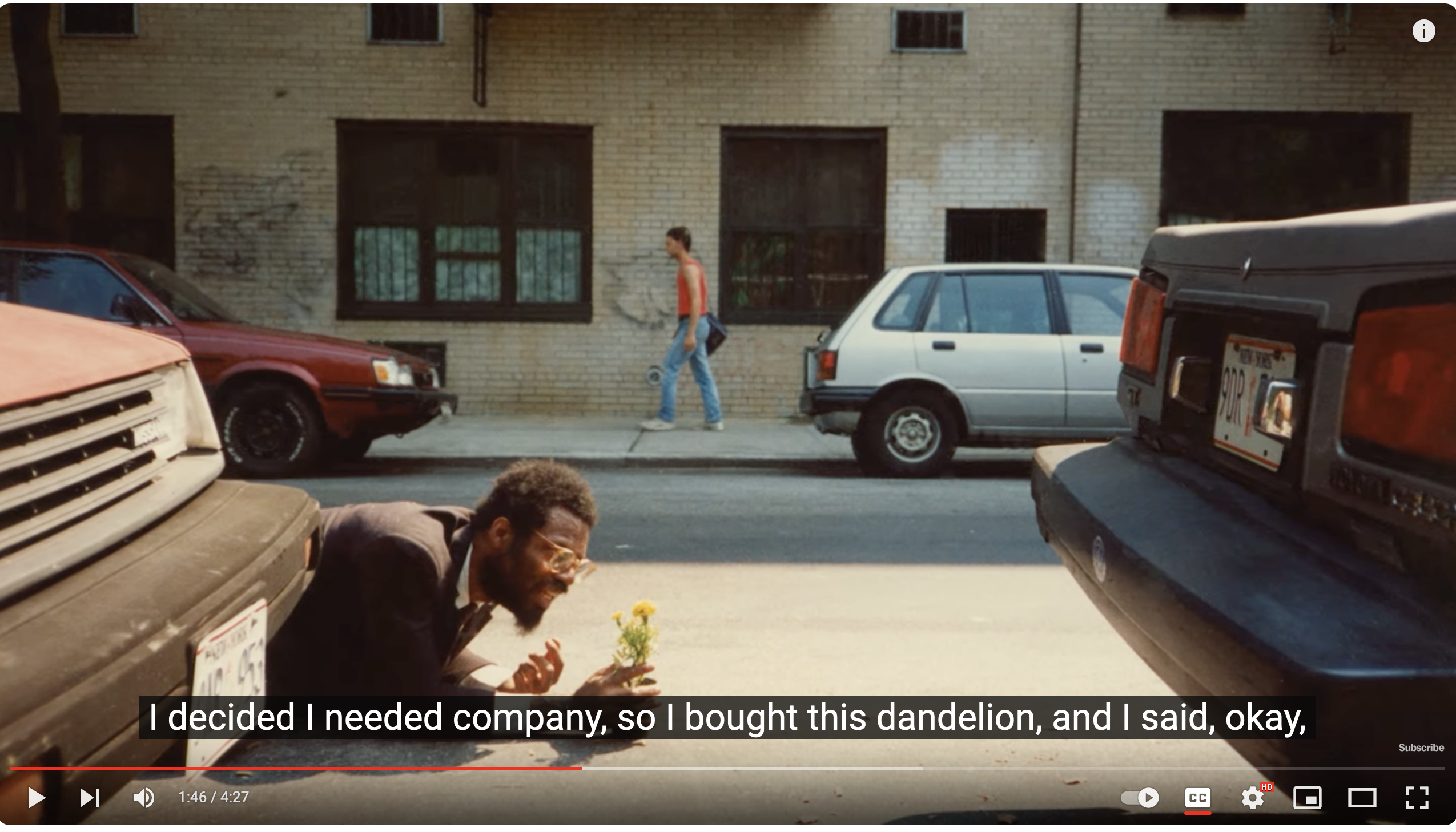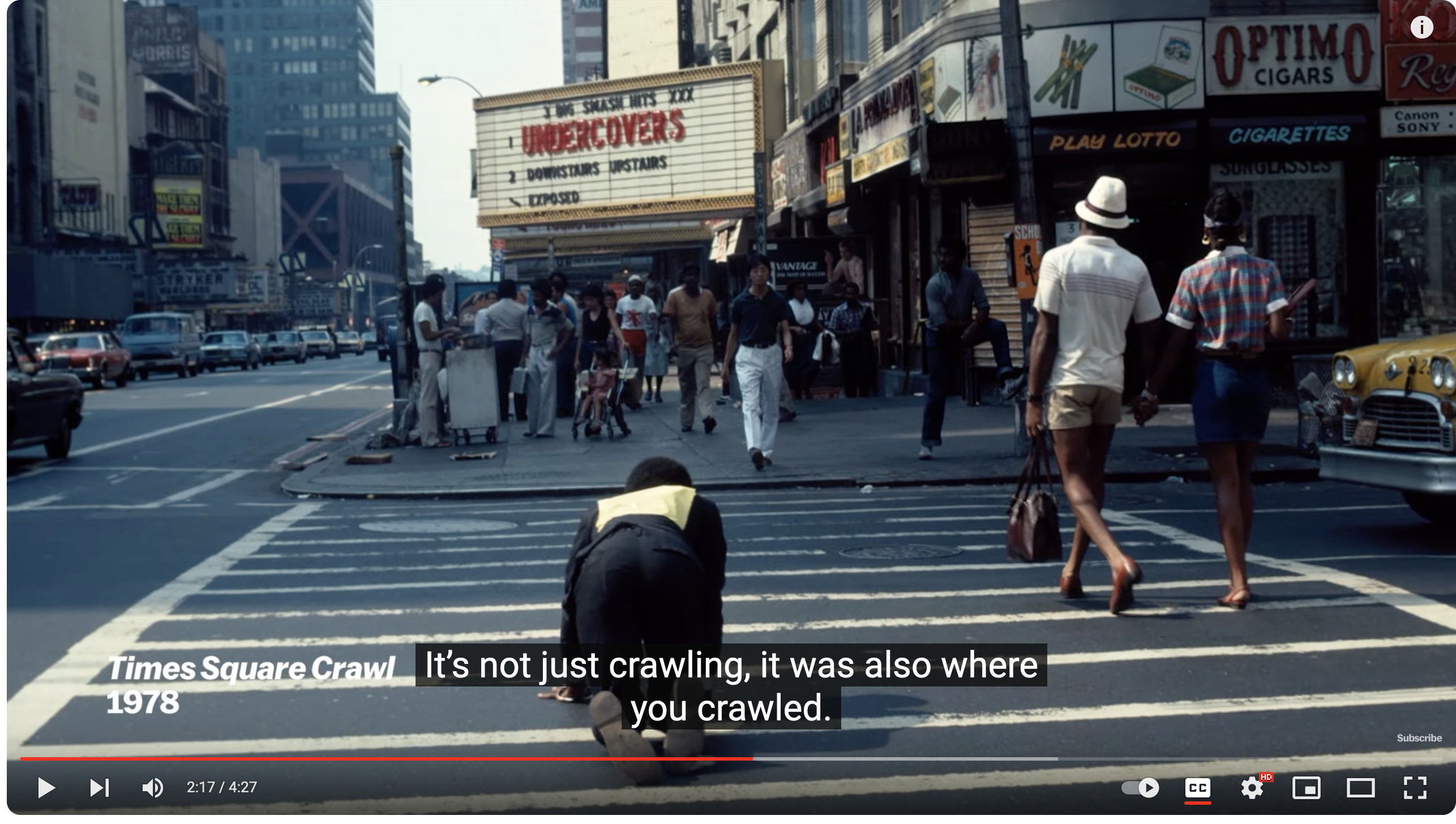Performance Art
“Snail’s Gallop”
More on the artist here.
Posted By: Paul - Sat Oct 05, 2024 -
Comments (0)
Category: Ineptness, Crudity, Talentlessness, Kitsch, and Bad Art, Avant Garde, Performance Art, Asia, Twenty-first Century
Rebecca Horn, RIP
Her Wikipedia page.
Posted By: Paul - Tue Sep 17, 2024 -
Comments (0)
Category: Ineptness, Crudity, Talentlessness, Kitsch, and Bad Art, Performance Art, Europe, Twentieth Century
“Dispatch from Solitude #1: Walking the Unknown Path”
The artist's homepage.Social Distancing & Art Episode 3 from Ogden Contemporary Arts on Vimeo.
Posted By: Paul - Mon Sep 16, 2024 -
Comments (3)
Category: Furniture, Hunting, Trapping and Other Wilderness Activities, Ineptness, Crudity, Talentlessness, Kitsch, and Bad Art, Avant Garde, Performance Art
The Singing Sculpture
The Singing Sculpture by the art duo Gilbert & George is well known, though I just discovered it recently. Info from wikipedia:It is also unusual for one of the pair to be seen without the other. The pair regard themselves as "living sculptures". They refuse to dissociate their art from their everyday lives, insisting that everything they do is art. They were listed as among the fifty best-dressed over-50s by The Guardian in March 2013.
It's now become common to see street performers painted in metallic paint. They pretend to be unmoving statues until someone gives them some money, and then they may move abruptly. You can find them in the downtown areas of many big cities, wherever there are a lot of tourists.
I wonder if Gilbert & George's Singing Sculpture was the original inspiration for this form of performance art? I haven't been able to find any direct confirmation of this, but nor have I been able to find any examples of 'Bronze Man' performers before 1969.
More info: "Gilbert & George's Singing sculpture"
Posted By: Alex - Fri Aug 30, 2024 -
Comments (1)
Category: Performance Art, 1960s
Man in a bottle
We previously met performance artist Abraham Poincheval back in 2017 when he sat on a dozen eggs until they hatched.Now he's enclosed himself in a giant bottle that's floating on the Canal Saint-Denis outside of the Olympic Stadium. His plan is to stay in there for ten days.
More info: SmithsonianMag.com

Posted By: Alex - Tue Aug 06, 2024 -
Comments (4)
Category: Boats, Performance Art
Aki Sasamoto: Delicate Cycle
The creator's Wikipedia page.
Posted By: Paul - Thu Jul 25, 2024 -
Comments (0)
Category: Art, Performance Art, Hygiene, Ineptness, Crudity, Talentlessness, Kitsch, and Bad Art, Asia
Episode in a small town library
Ian Breakwell's unusual photograph documents an "episode" that took place in an unnamed small town library in 1970. The episode seems to be a library user somehow transforming into, or sprouting, printed pages.
"Episode in a small town library" - Ian Breakwell, 1970
The only background information about the photograph that I've been able to find comes from Clare Qualmann's article "The Artist in the Library":
More detailed research into Breakwell's extensive archive held at Tate Britain did not provide answers in written form. Several versions of the image were published in journals, including Fotovision (August 1971), Art and Artists (February 1971) and Stand Magazine (Winter 1997). The different paper stocks that they were printed on enable more detail to be seen than the digital version that I had looked at before – in Art and Artists the photograph was reproduced on a newsprint insert to the magazine that is very different from the glossy black and white of the others. In this version, the chicken-wire frame underneath the newspaper is more visible, as are the titles on the bookshelf behind – Art and Civilization is clearly legible.
The version published in Fotovision has a completely different feel – instead of The Guardian newspaper on the table the artist holds a copy of Typographica magazine in his hands. Although this dates from 1964 (the photograph was taken in 1970), its cover design (an assemblage of logos arranged in a dense slanting pattern across the cover) juxtaposes old and new – the 'timeless' look of the traditional library space with the contemporary graphic design of the journal, and the branding that it is presenting. The existence of multiple versions suggests time spent in the space – time to shoot multiple images, test and trial different ideas and perform the image repeatedly (rather than a hit-and-runundercover-quick-photo-before-anyone-notices).
Posted By: Alex - Tue Jul 09, 2024 -
Comments (0)
Category: Photography and Photographers, Performance Art, Surrealism, Libraries, 1970s
Crying Artist
Controversy recently struck the General Theologial Seminary in New York after it invited an artist to perform in the college chapel. Details from Church Times:I know some people can cry on command, but for five hours?
The Episcopalian community thought the event sounded way too weird, forcing the seminary to cancel the performance before it happened.
Posted By: Alex - Sun Apr 14, 2024 -
Comments (2)
Category: Religion, Performance Art, Sadness
RIP Günter Brus
This video is a little gross, but hardly much by contemporary horror cinema standards.From his Wikipedia entry:
Brus was a co-founder in 1964 of Viennese Actionism (German: Wiener Aktionismus) with Otto Muehl, Hermann Nitsch, and Rudolf Schwarzkogler. His aggressively presented actionism intentionally disregarded conventions and taboos, with the intent of shocking the viewer. At the Kunst und Revolution event at the University of Vienna in 1968, Brus urinated into a glass then proceeded to cover his body in his own excrement, and during the performance Brus also sang the Austrian National Anthem while masturbating. Brus ended the piece by drinking his own urine and inducing vomiting, and was subsequently arrested. Through this piece and his other performance works, Brus hoped to reveal the still fascist essence of the nation. This performance created a public outrage at the time and the participants were dubbed by the media as uniferkel or "University Piggies." Sentenced to 6 months in prison after the event and subsequent public reactions, he fled to Berlin with his family and returned to Austria in 1976.
Posted By: Paul - Wed Feb 14, 2024 -
Comments (0)
Category: Misbehavior, Rebellion, Acting-out and General Naughtiness, Performance Art, Outrageous Excess, Europe, Twentieth Century, Nausea, Revulsion and Disgust
Pope.L, Crawl Artist, RIP
We don't want this recent death to get lost in the end-of-the-year chaos!His obituary.


Posted By: Paul - Wed Jan 03, 2024 -
Comments (0)
Category: Urban Life, Avant Garde, Performance Art, Twentieth Century, Twenty-first Century

| Who We Are |
|---|
| Alex Boese Alex is the creator and curator of the Museum of Hoaxes. He's also the author of various weird, non-fiction, science-themed books such as Elephants on Acid and Psychedelic Apes. Paul Di Filippo Paul has been paid to put weird ideas into fictional form for over thirty years, in his career as a noted science fiction writer. He has recently begun blogging on many curious topics with three fellow writers at The Inferior 4+1. Contact Us |




